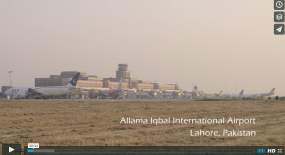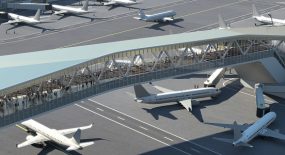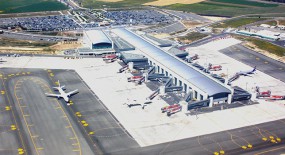
Historically, optimizing operational efficiency at airports has been difficult. The variety of distinct operational sectors has meant that many ‘silo’ sectors have become established as the norm. With an ever increasing number of constraints on airport operators – financial, environmental, safety, security, accessibility, regulatory and of course space – the pressure on management has never been greater to scrutinize the effects of integrated operational efficiency.
Disparate Situations.
Historically, optimizing operational efficiency at airports has been difficult. The variety of distinct operational sectors has meant that many ‘silo’ sectors have become established as the norm. Each has usually been run in a distinct way, driven by specific requirements – turnaround, safety, security, and crowd handling.
Retail outlets would have often been run as a franchise zone, subject to retail space regulations, and dramatically different to the same airport’s airside environment which would be bound by aviation constraints. There, the governance and working edicts of air safety, health and safety in hazardous environments, and air traffic on-time strictures would all apply. This often meant that in some instances the left (airside) hand was working completely out of sync with the right (landside) hand unless pulled into line by an overreaching management system.
Worse, this top level management system was often driven by external pressure based on national interest and regional aviation industry demands rather than operational efficiency.
Inconsistent Information Flow
According to the first report into integration produced by the US Transportation Research Board’s Airport Cooperative Research Program (ACRP), a lack of consistent, accurate and timely information is a direct result of a lack of applied technology and overall standardized industry practices.
Issues related to collecting, processing, integrating, and defining data keep airports from realizing the full value of completely integrating information
– Integrating Airport Information Systems, US Transportation Research Board
In addition, noted the ACRP report, although large and sophisticated airport operations generate and leverage deep and complex integrated data, airports of all sizes need a minimum data collection capability to manage their facilities effectively.
Indeed, in older airports, processes such as air traffic control, lighting systems, gate allocation, transit and transfer, security and immigration clearance, baggage handling, check-in operations, manpower deployment, catering, refuelling, maintenance and cargo would likely be competing with one another for manpower and priority queuing in the operational ground map.
In some cases, each of these sectors could have its own completely disparate operations centre in different locations within the airport. This duplication and lack of synchronicity would be driven mainly by the lack of commonality and the relatively paper and input-heavy legacy operations they used. All of which aggravated their inability to communicate directly into a common system. Liaison between sectors is still, in some extreme cases, through phone calls between local operations centers and ground level operators – not exactly a recipe for efficiency. Most often, this has grown outwards from a small, less complex legacy operation. But modern aviation demands higher standards.
Digital communications … improves various aspects of airport operations, such as customer engagement, improving operational efficiency and reducing delays, primarily in airport hubs with high capacity of transit passengers, says researcher Rami Elsamra in a QUT study paper on communications facilitation.
Digital communication offers a chance to ensure timely information sharing and consistency in the communication processes, as well as the ability of the airports or airlines to streamline operations and manage passenger expectations.
– Rami Elsamra, QUT researcher.
Today, the advent of sophisticated, integrated, digitally-based systems has allowed a revolution to take place. Intelligent systems track aircraft, passengers, baggage and regular requirements like fuel, food and cleaning through the lifespan of each aircraft’s allocated time at the airport. And best of all, the overall management of the entire airport can be managed and overseen from one centralized physical location.
Integration: Best for Both Old and New
This approach has been tested across not just new airports, but across many existing operations looking to upgrade. Issues like traffic expansion, holistic management, optimized operations and integrated solutions can all benefit from advanced, integrated analytics. As Christian Onselaere, CEO at integrator ADB SAFEGATE, noted recently, newly combined solutions and integrator expertise can help any airport take advantage of new digital technologies. These can offer an operation-wide, cost-effective way to increase operational efficiency, improve safety and enhance sustainability.
Through smart integration, ADB SAFEGATE is enabling airports and airlines to achieve the highest operational efficiency and to deliver the best possible passenger experience, he added.
ADB SAFEGATE is a leading provider of solutions that boost efficiency, improve safety and environmental sustainability and reduce operational costs for airports, airlines and ANSP’s. The company works with customers to identify performance bottlenecks and jointly solve them through integrated solutions that improve airport and airline performance. These solutions address every aspect from approach to departure – airport traffic handling and guidance, airfield lighting, tower-based traffic control systems, intelligent gate and docking automation, services and advanced analytics. ADB SAFEGATE has more than 1,100 employees across 45 nationalities in 25 countries, and operates in more than 175 countries, serving more than 2,500 airports globally, from the busiest and largest like Atlanta, Beijing, Dubai, Heathrow, Charles De Gaulle, Amsterdam, Frankfurt, Istanbul, New Delhi and Changi, to fast-growing airports across Asia and Africa.















Well described and very informative post it is. Thanks for sharing it with us.